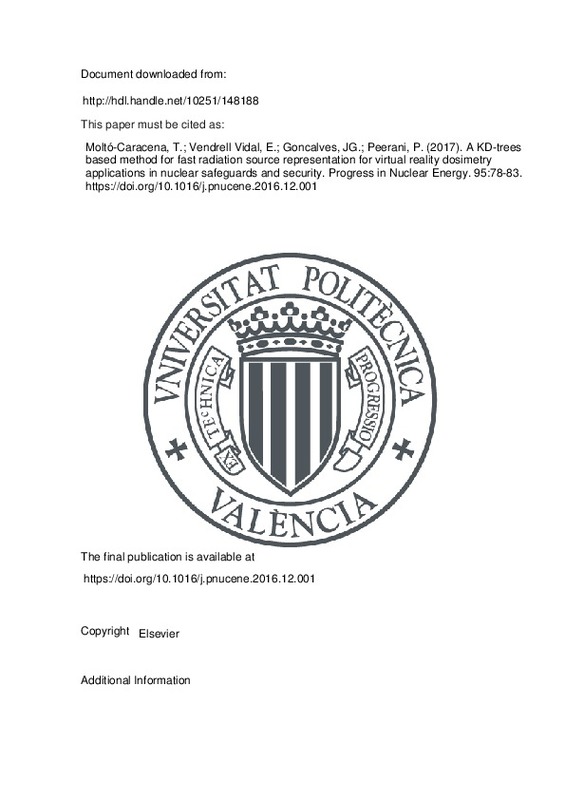JavaScript is disabled for your browser. Some features of this site may not work without it.
Buscar en RiuNet
Listar
Mi cuenta
Estadísticas
Ayuda RiuNet
Admin. UPV
A KD-trees based method for fast radiation source representation for virtual reality dosimetry applications in nuclear safeguards and security
Mostrar el registro sencillo del ítem
Ficheros en el ítem
| dc.contributor.author | Moltó-Caracena, Teófilo
|
es_ES |
| dc.contributor.author | Vendrell Vidal, Eduardo
|
es_ES |
| dc.contributor.author | Goncalves, Joao G.M.
|
es_ES |
| dc.contributor.author | Peerani, Paolo
|
es_ES |
| dc.date.accessioned | 2020-07-17T03:32:17Z | |
| dc.date.available | 2020-07-17T03:32:17Z | |
| dc.date.issued | 2017-03 | es_ES |
| dc.identifier.issn | 0149-1970 | es_ES |
| dc.identifier.uri | http://hdl.handle.net/10251/148188 | |
| dc.description.abstract | [EN] With the aim of demonstrating the concrete advantages that novel technologies such as Virtual (VR) can provide to the nuclear industry, the authors of this paper have been working on the development of a VR based simulator of a gamma dose rate detector for training purposes, to be applied in the field of nuclear security and safety. Historically in nuclear science, simulating gamma dose rate transport has had a series of requirements, most importantly the accuracy of the computation. When embedding this dose rate computation in the environment of a VR based application, a second and opposing key requirement appears: real time performance. Meeting this requirement is only possible if a fast method to compute gamma radiation is used. In order to achieve this target the authors have been working in ways of improving the efficiency of the Point-Kernel method by reducing its computational effort. This paper presents the latest step in this pursuit of efficiency; a novel method based on a non-regular kernel approach, combined with a KD-tree based volume division method. Devised to reduce as much as possible the number of points that represent the volume of the source while aiming at retaining sufficient dose computation accuracy. (C) 2016 Elsevier Ltd. All rights reserved. | es_ES |
| dc.description.sponsorship | This project is fully funded by the Institute of Transuranium Elements of the European Commission's Joint Research Centre, Ispra site, Italy. | es_ES |
| dc.language | Inglés | es_ES |
| dc.publisher | Elsevier | es_ES |
| dc.relation.ispartof | Progress in Nuclear Energy | es_ES |
| dc.rights | Reserva de todos los derechos | es_ES |
| dc.subject | Simulation | es_ES |
| dc.subject | Dose rate | es_ES |
| dc.subject | Gamma radiation | es_ES |
| dc.subject | Training | es_ES |
| dc.subject | Point kernel | es_ES |
| dc.subject.classification | INGENIERIA DE SISTEMAS Y AUTOMATICA | es_ES |
| dc.title | A KD-trees based method for fast radiation source representation for virtual reality dosimetry applications in nuclear safeguards and security | es_ES |
| dc.type | Artículo | es_ES |
| dc.identifier.doi | 10.1016/j.pnucene.2016.12.001 | es_ES |
| dc.rights.accessRights | Abierto | es_ES |
| dc.contributor.affiliation | Universitat Politècnica de València. Departamento de Ingeniería de Sistemas y Automática - Departament d'Enginyeria de Sistemes i Automàtica | es_ES |
| dc.description.bibliographicCitation | Moltó-Caracena, T.; Vendrell Vidal, E.; Goncalves, JG.; Peerani, P. (2017). A KD-trees based method for fast radiation source representation for virtual reality dosimetry applications in nuclear safeguards and security. Progress in Nuclear Energy. 95:78-83. https://doi.org/10.1016/j.pnucene.2016.12.001 | es_ES |
| dc.description.accrualMethod | S | es_ES |
| dc.relation.publisherversion | https://doi.org/10.1016/j.pnucene.2016.12.001 | es_ES |
| dc.description.upvformatpinicio | 78 | es_ES |
| dc.description.upvformatpfin | 83 | es_ES |
| dc.type.version | info:eu-repo/semantics/publishedVersion | es_ES |
| dc.description.volume | 95 | es_ES |
| dc.relation.pasarela | S\347971 | es_ES |
| dc.contributor.funder | Institute for Transuranium Elements | es_ES |







![[Cerrado]](/themes/UPV/images/candado.png)

